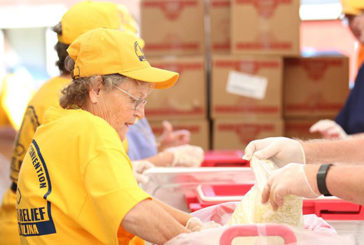To make it plain and simple, South Carolina Baptist Disaster Relief needs churches to send missions volunteers for statewide service in the coming year.
The effects of flooding in October 2015 are still being felt by dozens of Pee Dee residents, and disaster relief service has been complicated by the October 2016 flooding brought on by Hurricane Matthew.
It’s been a one-two punch to South Carolina Baptist Disaster Relief. “There’s no end in sight to the needs in South Carolina,” said Randy Creamer, director of South Carolina Baptist Disaster Relief.
“With regard to RebuildSC (our rebuild efforts from the October 2015 flooding), there’s no longer the media attention, but we still have more than 60 requests for help in rebuilding homes. These are not vacant homes; these are homes that people are still trying to occupy and live in because they have nowhere else to go.”
Currently, rebuild efforts are focused on the area around Johnsonville, a town of about 1,400 people in rural Florence County.
Creamer said that since Jan. 1, 2016, volunteer teams have responded to the Pee Dee from within South Carolina and throughout the country. Most are volunteers beyond state disaster relief teams, including collegiate ministry teams and church mission trips. The RebuildSC Project isn’t strictly limited to trained and certified disaster relief volunteers.
Leading the way in rebuilding South Carolina for much of 2016 were the North Carolina Baptist Men, who have been mobilized for rebuild since Hurricane Floyd in September 1999. However, when Hurricane Matthew rolled up the East Coast in October 2016, causing $1.5 billion in North Carolina flood damage, North Carolina Baptist men were forced to pull out of South Carolina. That left a gaping hole in volunteerism for the need remaining in South Carolina.

While South Carolina Baptist Disaster Relief feeding teams were active in the weeks following floods in 2015 and 2016, the greatest need now is for volunteers to help rebuild damaged homes and other structures in hard-hit areas of South Carolina.
“We can’t say enough about the partnership with North Carolina Baptist men,” Creamer said, “but Matthew caused a leadership transition, and I think it’s good that we take sole ownership of our rebuild project.”
Jack McCormick, a Mission Service Corps missionary through the North American Mission Board, is now serving on site in Florence County as the RebuildSC coordinator as well as construction coordinator. His work is being funded by South Carolina Baptist Disaster Relief in partnership with Saluda Baptist Association in Anderson. McCormick is working closely with Florence Baptist Association and director of missions Chris Smith.
“We need consistent, ongoing volunteers,” Creamer said. “North Carolina had a huge database from which to call upon and draw volunteers. They also used their own disaster relief feeding teams. They brought all of that with them. Now they are gone.”
South Carolina Baptists are needed to come alongside others who are coming to help. An Amish group is coming during the first quarter of 2017 by way of the North Carolina connection. This spring, South Carolina Baptist Disaster Relief is hosting national collegiate groups that are coming through the North American Mission Board. Biltmore Baptist Church in Asheville is sending teams in March, and part of that service is to include a block party for residents in and around Johnsonville.
“We are hoping South Carolina Baptist churches and volunteers will adopt a home to rebuild or a disaster relief project within our state during 2017,” Creamer said. “Youth groups, adult groups, mission teams: Come and get to know the area, get to know the scope of the work, and then send teams to help. South Main Baptist Church in Greenwood has decided to focus on meeting needs in our state and will be sending multiple teams. We need others to follow that example.”
Besides rebuilding about 165 occupied homes from the 2015 flooding, South Carolina Baptist Disaster Relief mobilized trained volunteers for tree removal and chainsaw work following Hurricane Matthew. Normally, South Carolina would have benefitted from disaster relief teams coming from other East Coast state conventions, but those volunteers are staying at home because of the hurricane’s damage in many states.
“We had eight requests from Marion just in the past week,” Creamer said, two months after the hurricane. “So far, there have been 624 chainsaw jobs, and many of these are huge, old trees. Believe it or not, it’s taken a full day to remove just one tree in some places.
“Ron Taylor and the Pee Dee Association are in the thick of it. From Hurricane Matthew, we are seeing the largest tree event, from Hilton Head to Chesterfield, since Hurricane Hugo in 1989. Feeding units served more than 113,000 meals this fall — the largest feeding operation since Hugo.
“Between RebuildSC from the 2015 flooding, the loss of out-of-state volunteers, and then the chainsaw work brought on by the 2016 hurricane, there’s more work than we can physically do. We know the United Methodists are out working in our state, World Changers have been here, Baptist Collegiate Ministry students are at work on their break, and even teenagers are working, but the whole thing is so widespread we can’t possibly get to everyone without the hand of God and full statewide cooperation from our churches.”
For more information on service and to volunteer, contact South Carolina Baptist Disaster Relief at 803-227-6149 or by e-mail: sueharmon@scbaptist.org.

